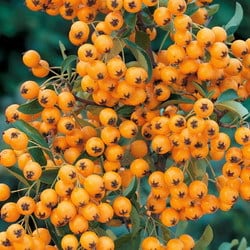Last updated on March 28th, 2016
Our site is reader supported, this means we may earn a small commission from Amazon and other affiliates when you buy through links on our site.
There are many varieties of Pyracantha some are better for hedging some are better as wall trained specimens or planted in the shade where some varieties may not do very well.
Pyracantha ‘Soleil d’Or’ (Firethorn)
Pyracantha ‘Soleil d’Or’ which is also known as Firethorn ‘Soleil d’Or’ is a evergreen shrub with large prickly thorns and small green glossy leaves. It is commonly used as a hedging plant but is also popular as a garden shrub and can be trained against a wall.
It flowers from early May-June like other varieties of Pyracantha and then produces bright yellow berries in the Autumn attracting wildlife into the garden. It typically grows to around 300cm but can be kept at any height by being pruned.
- Position: Full Sun/Partial Shade
- Planting Area: Fertile well-drained soil is best but will grow in most soils
- Flowers: White flowers in May-June followed by yellow berries in Autumn
- Hardiness: Hardy
- Height: 300cm but can be pruned to any size
Pyracantha ‘Red Column’ (Firethorn)

Pyracantha ‘Red Column’ is also known as Firethorn ‘Red Column’ and is a evergreen shrub with large prickly thorns. This variety is commonly used as a hedging plant but is also popular as a garden shrub and can be trained against a wall.
It flowers from early May-June and then produces bright red berries in the Autumn attracting wildlife into the garden. It typically grows to around 300cm but can be kept at any height by being pruned.
- Position: Full Sun/Partial Shade
- Planting Area: Fertile well-drained soil is best but will grow in most soils
- Flowers: White flowers in May-June followed by red berries in Autumn
- Hardiness: Hardy
- Height: 300cm but can be pruned to any size
Pyracantha ‘Mohave’ (Firethorn)

Pyracantha ‘Mohave’ also known as Firethorn ‘Mohave’ is a evergreen shrub with large prickly thorns and small green glossy leaves. It is commonly used as a hedging plant but is also popular as a garden shrub and can be trained against a wall.
It flowers from early May-June and then produces bright orange/red berries in the Autumn attracting wildlife into the garden. It typically grows to around 300cm but can be kept at any height by being pruned.
- Position: Full Sun/Partial Shade
- Planting Area: Fertile well-drained soil is best but will grow in most soils
- Flowers: White flowers in May-June followed by orange/red berries in Autumn
- Hardiness: Hardy
- Height: 300cm but can be pruned to any size
- Disease Resistance: Resistant to Fireblight and Scab
Other Pyracantha varieties include:
Pyrancantha ‘Firelight’

Pyracantha ‘Golden Charmer’

To read more on Pyracantha ‘Golden Charmer’ – click here
- Pyracantha ‘Apache’ (Grows to approx 6ft tall, Red berries, grow to around 6ft is resistant to Pyracantha Scab and Fireblight)
- Pyracantha ‘Fiery Cascade’ (Grows to 8ft tall, Produces orange berries which turn more red in winter, disease resistant)
- Pyracantha ‘Gnome’ (Grows to 8ft tall, produces orange berries, very susceptible to Scab)
- Pyracantha ‘Lowboy’ (Grows to only 2-3ft, produces orange berries and is prone to Scab)
- Pyracantha ‘Tiny Tim’ (Compact shrub which grows to only 3ft, produces red berries)
-
Pyracantha ‘Coccinea’ (Grown as a shrub this firethorn will grow 8-10ft in size but will spread further when trained along a wall or fence)
- Pyracantha ‘Lalandei’
- Pyracantha ‘Navajo’
- Pyracantha ‘Orange Glow’
- Pyracantha ‘Rosy Mantle’
- Pyracantha ‘Santa Cruz’
- Pyracantha ‘Soleil d’Or’
- Pyracantha ‘Teton’ (Grows to 12ft tall but only around 4ft wide, golden yellow berries, resistant to Fireblight and Scab)
- Pyracantha ‘Watereri’ (Crimson berries and is a nearly thornless variety)
To reduce the the effects of diseases you can buy varieties which are disease-resistant which include Pyracantha ‘Apache, Pyracantha ‘Fiery Cascade’, Pyracantha Mohave, Pyracantha ‘Navaho’, Pyracantha ‘Pueblo’ Pyracantha ‘Rutgers’, Pyracantha ‘Shawnee’ and Pyracantha ‘Teton’.
Other articles you may be interested in:
Pruning and training Pyracantha
How to plant a Pyracantha Hegde
